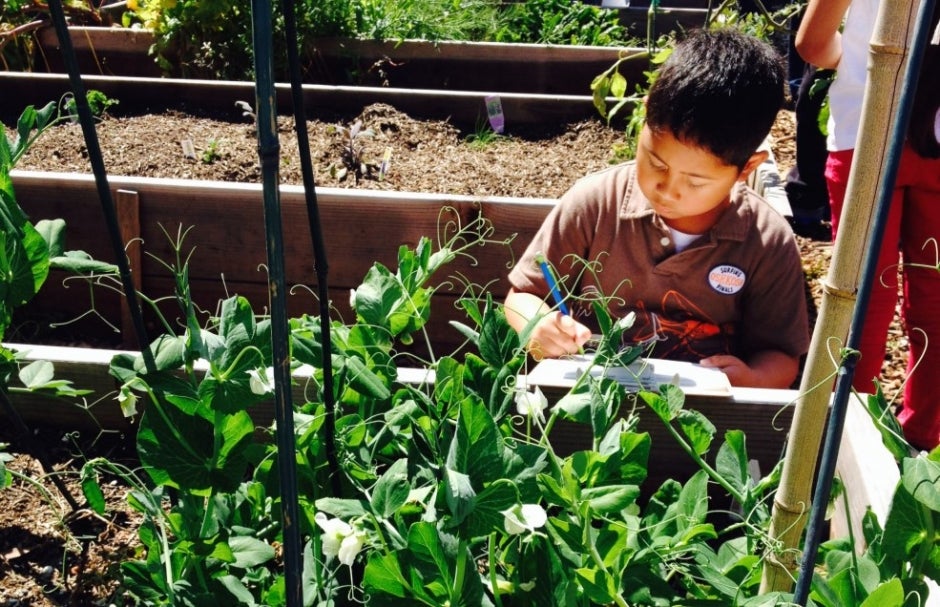Starting Small for Big Gains
Case Study: Schools Gardens at George Washington Elementary School
Students at George Washington Elementary School in Daly City, CA are an urban bunch. While they have some exposure to where fruits and vegetables come from, they by-and-large aren’t really “in the mix” with cooking and food prep. Their recreation outside of school hours consists largely of video games and other indoor activities, shares Parent-Teacher Association (PTA) volunteer Azjah Robertson. Understanding this dynamic and wanting to change it, a few PTA parents, the Daly City Partnership and a small group of teachers sought out resources and secured funding from Lowe’s Home Improvement to transform an underutilized plot of land into a raised bed garden.
“The value of a school garden is obvious once people see what they can do. Here students can experiences the same things they are learning about in class in a real-world, hands-on way. When you think about it, it really functions as an on-site field trip.” -Azjah Robertson
While this seed money got the ball rolling, it wasn’t enough. “We wanted teachers to feel like they could use [the garden],” remarked Azjah. “We saw the pull and the attraction, but also the real hesitancy and uncertainty about really jumping in and how to do so.” Teachers were eager to get their hands on simple, manageable lesson plans that were built into the already-existing curriculum.
The Solution: Teacher Training
Securing Get Healthy Community Implementation Funding made it possible to bring in an experienced teacher from San Francisco who specialized in outdoor education to conduct a series of after school professional development sessions. While the group considered sending the teachers to off-site professional development at facilities with more well established gardens, in the end the choice was made to prioritize learning in the school’s own garden, so that teachers could “really learn what to do here, and to feel confident and comfortable doing so.”
Nearly 50 percent of the teachers participated in the professional development series, which included hands-on simulations and lesson planning resources covering topics ranging from seed and plant knowledge to strategies for maintaining healthy soil to developing norms for sharing the garden amongst the multiple interested classrooms. This professional development proved instrumental in helping teachers see that they really could use the garden in meaningful ways to help enhance their students’ learning; after the training, garden use increased to as much as two visits per month by some classrooms and individual classrooms took ownership of different boxes to ensure the garden ecosystem continued to thrive.
The Essential Ingredient for Success: Don’t be Afraid to Start Small!
Needing to dedicate several hours per week to set the garden project in motion proved challenging for Azjah and the other teacher-leaders, however their commitment has paid off as they have been able to witness the impact of the garden growing and evolving over the past few years. “The financial resource doesn’t have to be huge, if you can just get it started,” remarks Azjah. “Starting small is not a bad thing…it helps people see that it is manageable and that it can be done. You can’t expect to go from a dirt patch to amazing integration in one year—or even five— and that’s ok. A garden is a process that builds on itself, and it’s valuable for the students to see that.”
Kindergarten teacher Juline Draper observed how the garden was slowly helping to balance the school culture— one that in years past had focused heavily on testing and rigid curriculum—to view the garden as a valid learning activity. “If you know that it’s valued, and that people understand the research behind it, it can make you more comfortable to do the extra work required to incorporate garden time and activities into the curriculum. It takes time to build, but it’s worth it.”
Challenge: Support
By far, the biggest concern about the garden is long-term sustainability—making sure the garden continues to thrive and be incorporated into the curriculum. While Azjah and a small group of other dedicated parents and teachers have been able to harness grant resources to get the garden started, she estimates that they really can function at most one more school year without the dedicated support of a part-time garden coordinator. In addition to the behind-the-scenes coordination that is required to recruit and organize parent volunteers to help with general upkeep, a garden coordinator would serve as support for a teacher—who would otherwise be alone—to ensure that students are maximally engaged and supported during lessons. As Ms. Draper sums up, “If we were supported in incorporating the garden into our curriculum more regularly, the students would come to expect and value their garden time and I know they’d get a lot more out of it.”
Looking to the Future
For George Washington Elementary, Azjah shares that, “We would like to move beyond using the garden mainly to teach about the life cycle and do more with making connections to nutrition and healthy eating, we just haven’t been able to get there yet.” While she sees the beginnings of this happening already, she sees a role for bigger systemic change in helping advance this work: “I really do believe that this is one of the cheapest and most engaging ways to teach about the health and the environment. [Outdoor education] should be part of health and environmental policy.”


